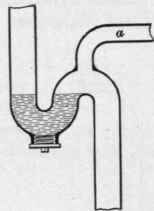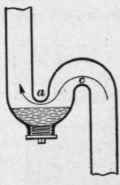Vents And Siphonage
Description
This section is from the book "A Treatise On Architecture And Building Construction Vol4: Plumbing And Gas-Fitting, Heating And Ventilation, Painting And Decorating, Estimating And Calculating Quantities", by The Colliery Engineer Co. Also available from Amazon: A Treatise On Architecture And Building Construction.
Vents And Siphonage
120. The water which seals a trap is very likely to be drawn out by the suction of the water which passes down the waste pipe, unless some means be used to destroy the suction. The waste water should always be driven through the trap by hydraulic pressure, instead of being pulled through by suction. Suction can be entirely prevented by attaching an air or vent pipe, as shown at a in Fig. 42. The effect of siphonage is shown in Fig. 43. The suction will continue until the level of the flowing water falls below the tongue of the trap at a when air will enter and stop the suction. The water between a and c still has considerable momentum, and some of it will pass over c, but the remainder will fall back into the lower bend. This quantity, however, is too small to fill the bend, consequently, an opening is left which permits the back flow of sewer gas, as shown by the arrow.
121. A local vent is a device for creating an outward current of air, for the purpose of carrying away the offensive odors which arise in the bowl of a water closet, urinal, or other fixture. It is attached between the fixture and the trap, or to the fixture itself.
Local vents should never be connected to the main ventilating stack, nor to any trap or soil-pipe vent, because if they are so connected, the gases from the soil pipe will be driven back into the house during stormy or windy weather. To secure a current of air that will be effective, the local vent pipe should be carried upwards, inside of a chimney flue which is in constant use; or the pipe may be run outside, but close against the flue so that the heat of the chimney will help to create a draft. The outlet of the pipe should have a cowl, to prevent the wind from blowing downwards in it. A local vent is useless without a good draft. The pipe should not be less than 2 inches in diameter for one closet, or urinal, 3 inches for two or three closets, or urinals, and 4 inches in diameter for four or five closets, or urinals, if its length is not over 50 feet. It should be larger if the pipe is much longer or if it contains a number of bends.

Fig. 42.

Fig. 43.
Continue to:


